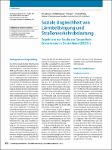Soziale Ungleichheit von Lärmbelästigung und Straßenverkehrsbelastung
Ergebnisse der Studie zur Gesundheit Erwachsener in Deutschland (DEGS1)
Laußmann, Detlef
Haftenberger, Marjolein
Lampert, Thomas
Scheidt-Nave, Christa
In der „Studie zur Gesundheit Erwachsener in Deutschland (DEGS1)“ wurden die Assoziationen von Lärmbelästigung und Straßenverkehrsbelastung mit soziodemografischen, sozioökonomischen und regionalen Merkmalen sowie mit Wohnverhältnissen an einer bevölkerungsbezogenen Stichprobe von 7988 18- bis 79-Jährigen untersucht. Die Lärmbelästigung und die Straßenverkehrsbelastung wurden mittels Selbstausfüllfragebögen erfasst. Insgesamt gaben 6,3% der Teilnehmer eine starke oder sehr starke Belästigung durch Straßenverkehrslärm, 3,7% durch Nachbarschaftslärm und 2,1% durch Fluglärm an. Eine hohe Straßenverkehrsbelastung wurde von 21,5% der Teilnehmer angegeben. Eine starke Belästigung durch Straßenverkehrs- oder Nachbarschaftslärm war signifikant assoziiert mit einem geringen Netto-Äquivalenzeinkommen und schlechten Wohnverhältnissen. Darüber hinaus war Nachbarschaftslärm mit einem niedrigen Sozial- und Berufsstatus assoziiert. Eine starke Fluglärmbelästigung war nur mit einem geringen Netto-Äquivalenzeinkommen und mit Wohnen in Mehrfamilienhäusern verbunden. Eine starke Belastung durch Straßenverkehr stand mit allen untersuchten Gliederungsmerkmalen im Zusammenhang. Umweltbelastungen sind auch gegenwärtig in Deutschland noch sozial ungleich verteilt und können zu negativen gesundheitlichen Folgen in benachteiligten Bevölkerungsgruppen führen. To study the associations of annoyance to noise and exposure to residential traffic with sociodemographic, socioeconomic and regional characteristics as well as housing conditions, a population-based sample of 7,988 adults 18–79 years of age was studied in the German Health Interview and Examination Survey for Adults (DEGS1). Annoyance to noise and exposure to residential traffic were assessed by self-administered questionnaires. A total of 6.3% of the participants reported a high to very high exposure to residential traffic noise, 3.7% to neighbourhood noise and 2.1% to aircraft noise. An excessive exposure to residential traffic was reported by 21.3% of the participants. A high annoyance to traffic and neighborhood noise was associated with a lower equivalised disposable income and poor housing conditions. Additionally annoyance to neighborhood noise was associated with low socioeconomic and occupational status. A high annoyance to aircraft noise was only associated with a low equivalised disposable income and living in apartment blocks. Exposure to residential traffic was associated with all investigated indicators. At present in Germany environmental exposures are social unequally distributed and may lead to negative health consequences in social disadvantaged groups. An English full-text version of this article is available at SpringerLink as supplemental.
Files in this item
No license information

